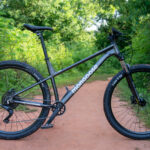For years, 26-inch wheels were the undisputed standard in mountain biking. While larger wheel sizes have gained popularity, 26-inch mountain bike tires continue to hold a strong position among riders. They are known for their agility, robust strength, and responsiveness, making them a versatile choice for various terrains and riding styles. Whether you’re tackling technical trails, enjoying cross-country adventures, or hitting your local bike park, understanding the benefits of 26-inch mountain bike tires is key to optimizing your ride.
The Enduring Appeal of 26-Inch Mountain Bike Tires
Despite the rise of 27.5 and 29-inch wheels, 26-inch mountain bike tires maintain several advantages that appeal to many cyclists. Their smaller diameter translates to enhanced maneuverability and quicker acceleration. This is particularly beneficial on tight, twisty trails and when navigating challenging obstacles. The lighter weight of 26-inch wheels and tires can also make bikes feel more nimble and easier to handle, especially for smaller riders or those who prefer a more playful riding style. Furthermore, 26-inch tires often offer a more affordable option and a wider selection of older, compatible bikes, making them accessible to a broader range of riders.
Exploring Different Types of 26-Inch Mountain Bike Tires
The world of 26-inch mountain bike tires is diverse, offering specialized options for every riding condition and preference:
-
Knobby Tires: These are the classic mountain bike tires, featuring aggressive tread patterns designed for maximum grip on loose dirt, rocks, roots, and mud. The pronounced knobs dig into the terrain, providing excellent traction for climbing, descending, and cornering in challenging off-road environments.
-
All-Mountain Tires: Striking a balance between grip and rolling efficiency, all-mountain tires are versatile performers suitable for a wide range of trail conditions. They typically feature medium-sized knobs that provide good traction on varied surfaces while still allowing for decent speed on smoother sections.
-
Cross-Country (XC) Tires: Designed for speed and efficiency, XC tires prioritize fast rolling and lightweight construction. They often feature smaller, closely spaced knobs or even semi-slick designs to minimize rolling resistance and maximize pedaling efficiency on hardpack trails and climbs.
-
Downhill (DH) Tires: Built for aggressive downhill riding, DH tires are engineered for maximum grip, durability, and puncture resistance. They feature large, widely spaced knobs for exceptional traction at high speeds and on steep, technical descents. Reinforced sidewalls and robust construction are essential to withstand the demands of downhill riding.
-
Tubeless Ready Tires: Many modern 26-inch mountain bike tires are tubeless-ready, allowing riders to run them without inner tubes. Tubeless setups offer several benefits, including the ability to run lower tire pressures for improved traction and comfort, as well as reduced risk of pinch flats.
Key Features to Consider When Choosing Your 26-Inch Mountain Bike Tires
Selecting the right 26-inch mountain bike tires involves considering several key features to match your riding style and terrain:
-
Tread Pattern: As mentioned earlier, the tread pattern is crucial for determining a tire’s grip and rolling characteristics. Choose knobby treads for loose and technical terrain, smoother treads for hardpack and XC riding, and versatile treads for all-mountain adventures.
-
Tire Width: Width significantly impacts traction, rolling resistance, and comfort. Wider tires (2.3″ and above) offer greater grip and stability, especially on technical trails and loose surfaces. Narrower tires (2.2″ and below) roll faster and are lighter, making them suitable for XC and faster trails.
-
Tubeless Compatibility: If you’re looking for enhanced performance and flat protection, consider tubeless-ready 26-inch mountain bike tires. Ensure your rims are also tubeless-compatible for proper setup.
-
Casing and Sidewall Protection: The tire casing affects ride quality and durability. Higher TPI (threads per inch) casings generally offer a smoother, more supple ride. Reinforced sidewalls provide added protection against cuts and punctures, particularly important for rocky and technical trails.
-
Compound: Tire rubber compound influences grip and wear. Softer compounds offer better grip but may wear faster, while harder compounds are more durable but may sacrifice some traction. Dual-compound tires combine a harder center for rolling efficiency with softer shoulders for cornering grip.
Frequently Asked Questions About 26-Inch Mountain Bike Tires
Are 26-inch mountain bike tires still a relevant choice in modern mountain biking?
Absolutely. While larger wheel sizes have become dominant in some segments, 26-inch mountain bike tires remain highly relevant, especially for riders who value agility, maneuverability, and affordability. They excel on technical trails, are often preferred by smaller riders, and are readily available for a wide range of bikes.
What 26-inch mountain bike tire width is best for me?
- 2.0″ – 2.2″: Ideal for cross-country riding, hardpack trails, and riders prioritizing speed and efficiency.
- 2.3″ – 2.5″: A versatile width suitable for trail riding, all-mountain adventures, and providing a good balance of grip and rolling resistance.
- 2.5″+: Recommended for aggressive trail riding, enduro, and downhill, offering maximum grip and stability on challenging terrain.
Can I convert my 26-inch mountain bike tires to tubeless?
Yes, if your rims and tires are tubeless-ready. Converting to tubeless can enhance your riding experience with improved traction, comfort, and fewer flat tires.
How often should I replace my 26-inch mountain bike tires?
Tire lifespan depends on several factors, including riding frequency, terrain, tire compound, and riding style. Inspect your tires regularly for wear and tear. Replace them when you notice worn tread, sidewall damage, or a significant decrease in performance. Generally, you can expect to replace mountain bike tires every 1,500 to 3,000 miles, but this can vary.
Find Your Perfect 26-Inch Mountain Bike Tires Today
26-inch mountain bike tires offer a compelling blend of performance, agility, and value for a wide range of riders. Explore our extensive selection of 26-inch tires to find the ideal match for your bike and riding style. Upgrade your mountain biking experience with tires engineered for durability, traction, and control on any trail.

